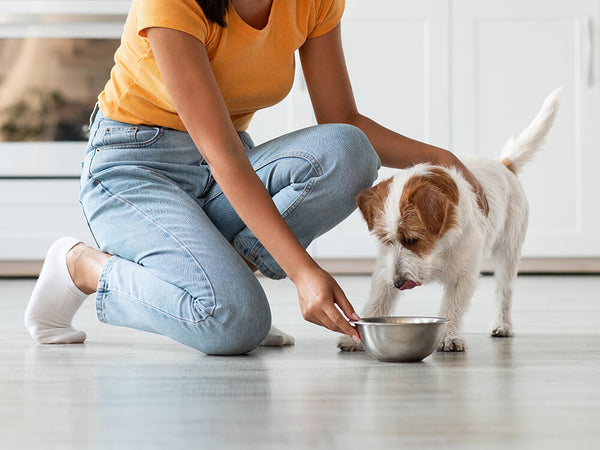All About Raw Food for Dogs and Cats
Written by: Dr. Jean Hofve, Holistic Veterinarian, DVM
Our animal companions are natural hunters and carnivores - just look at their ancestry. The dog at your feet (or on your sofa) has evolved from the wolf, and his digestive system is virtually the same despite thousands of years of domestication. They have very short intestinal tracts geared to the consumption and digestion of raw foods. Dogs are considered "omnivores" as they eat a variety of grasses, berries and vegetables in addition to prey. The cat on your lap is a true or "obligate" carnivore (meat only diet) and is specially designed by nature to hunt small rodents and birds. Her digestive tract, as well, is intended to assimilate raw meat best.
The Benefits of Raw
Diet is the foundation of maintaining good health. The fresher the diet, the more nutrients are available for the animal's system to utilize in supporting the immune system. Raw food diets may help support healthy teeth and gums, support skin and coat health, as well as support normal gastrointestinal health and function.
Raw diets have been common practice in European countries for decades, especially Germany, where they are commonly recommended by veterinarians. The fear of feeding raw meat in this country seems to stem from a fear of salmonella, E. coli and parasites. In over 10 years of feeding raw food and seeing countless animals on raw food diets in my practice, salmonella and E. coli have not been prevalent. Remember, pets' digestive systems are designed to accommodate raw meat. Parasites could be contracted through eating wild, whole prey or game meats, but should be less likely to occur with properly handled human grade meats. Infection is more likely to occur through a pet's ingestion of feces or soil, or from poorly handled meat.
The actual research sited in the US in support of a raw diet helps demonstrate this notion. A long-term study conducted by Francis M. Pottenger, Jr., MD, between 1932 and 1942 was initiated a bit by accident. Dr. Pottenger kept cats as laboratory animals for experiments in human health. As his research and cat population grew, he resorted to feeding them raw meat scraps from a local packing plant instead of cooked kitchen leftovers. Within a few months, he noticed changes in the cats eating raw meat. This prompted Dr. Pottenger to undertake a whole new experiment. He segregated cats into different groups - some of which were fed a cooked meat diet and others who received a raw meat diet. All observations were noted in great detail over many generations of cats. At the end of the study, Dr. Pottenger concluded that cats fed a heat processed diet were deficient and suffered from various health matters ranging from low immunity, irritability, and allergies to skeletal deformation, organ malfunction, poor development during kitten-hood, low birth rate, birth defects, infertility, and shortened life-span. If you wish to learn more about the Pottenger study, you can purchase a summary of the study as book or video from the Price-Pottenger Nutrition Foundation.
Some exceptions to "raw is better" are older, weaker animals who may not tolerate raw food, or animals with certain gastrointestinal conditions where herbs and supplements may be used to support gut health. In these cases, a home prepared, cooked diet can be a good substitute for a raw food diet.
Types of Raw Food Diets
Ideally, our companions would eat an all-raw diet that includes some organ meat and bones. Generally, it is my opinion that the more raw food you can include in your companion's diet, the better, but some is better than none. Some guardians choose to feed their companions a ½ raw and ½ dry (dehydrated or kibble) diet - either mixing the two or feeding raw for one meal each day and dry or cooked for the other. It does not have to be complicated – you can feed raw chicken and turkey necks and chicken backs as part or all of a meal several times a week. Raw poultry bones do not splinter, they crunch. This is a great way to support healthy teeth and normal periodontal health. As always, naturally raised, hormone- and antibiotic-free or organic meat is best.
When introducing raw bones to dogs they may experience diarrhea, constipation, or both as their systems adjust. Remember to go slowly and feed small amounts at first. When beginning the introduction of raw bones, it may be helpful to crush them with a hammer or in a meat grinder until your dog becomes fully transitioned to a raw diet. For cats bones should always be ground. If your companion has a delicate digestive system, consider grinding meat and bones through a 1/4-inch blade before feeding. Ground bones do not have the same teeth cleaning benefits as whole bones, however. You may also see similar symptoms as your companion's system goes through a detoxification process during the transition to a raw food diet. Again, the key is to go slowly and monitor your pet closely.
Only Natural Pet offers a wide range of commercial frozen raw foods that are available either in a formula of raw meat, grains, and fresh vegetables designed to provide complete nutrition, or as pure raw meat designed to be added as a supplement to other types of food. We also offer vegetable and/or grain-based mixes by Sojo's that are designed to be added to raw or cooked meat. You simply re-hydrate the mixture and add the meat. Also, see the following section for information about dehydrated and freeze-dried mixes that already have meat in them.
Obvious precautions should be taken when feeding raw meat – wash hands thoroughly after handling the raw meat. Thaw meat in the refrigerator, not sitting on the counter at room temperature. Warm water can be used to thaw or warm the food after it has been mostly thawed in the refrigerator. Do not microwave raw food as the live enzymes can be damaged and bones can harden even in just 30 seconds of microwaving. I do recommend avoiding pork as it has been shown to be a source of Trichinella. If you are thinking about bacteria, you can rinse it with several drops of food-grade hydrogen peroxide in a sink of water or 1/2 teaspoon liquid grapefruit seed extract in a sink of water to help kill surface bacteria.
Dehydrated and Freeze-Dried Alternatives
Although most people think of frozen formulas when they think of raw food for pets, there are less expensive and more convenient alternatives available in the form of dehydrated and freeze-dried formulas. These formulas are made from raw meat, vegetables, and fruits and have the water removed from them through either dehydration or freeze-drying, so that all you need to do is add water before feeding your pet. These offer the nutritional benefits of raw food, but are easier to handle and prepare and also tend to be less expensive. Freeze-dried formulas are very light weight, and so are great for travelling, but tend to me more expensive than dehydrated, so they are used mostly for cats and small dogs. Dehydrated food is more expensive than dry kibble, but not by a lot (around a dollar per day for a 40-pound dog), and it is much healthier than dry kibble. The favorite around Only Natural Pet is our EasyRaw formula, which is not only the most cost effective dehydrated alternative, but looks a lot like a bowl of soup you might have for lunch once it's re-hydrated!
Transitioning to Raw Food
It is best to introduce raw food slowly into your companion's diet over the course of two weeks. If your companion is used to having food available throughout the day, you can first transition him or her to eating only once or twice per day for dogs, and two to three times per day for cats before beginning the transition to raw food. Consider transitioning fully to raw in the beginning even if you ultimately intend to feed a mix of raw and cooked or dry. This will help maintain proper gut flora and support normal digestive function. You can start with 1 teaspoon for small dogs and cats and 1 tablespoon for larger dogs for three days or so. Then increase to 2 teaspoons or tablespoons for several days, decreasing the amount of regular food by ¼ to ½ in general proportion to the raw. You can work up to replacing at least ½ the normal diet for several days. Finally, you can replace one full meal with raw for a day or two, then fully transition to raw.
We recommend supplementing with digestive enzymes and probiotics for at least the first two weeks to support healthy digestion. If your animal is resistant to the raw at first, you may want to use a bit of canned food to entice them. Cats, in particular, can be resistant to a change in diet. They tend to fixate on whatever food they are weaned onto and will resist switching to a different diet. We have found that grinding or shredding their favorite treat on top of the food can help. Freeze dried treats work well for this.


















